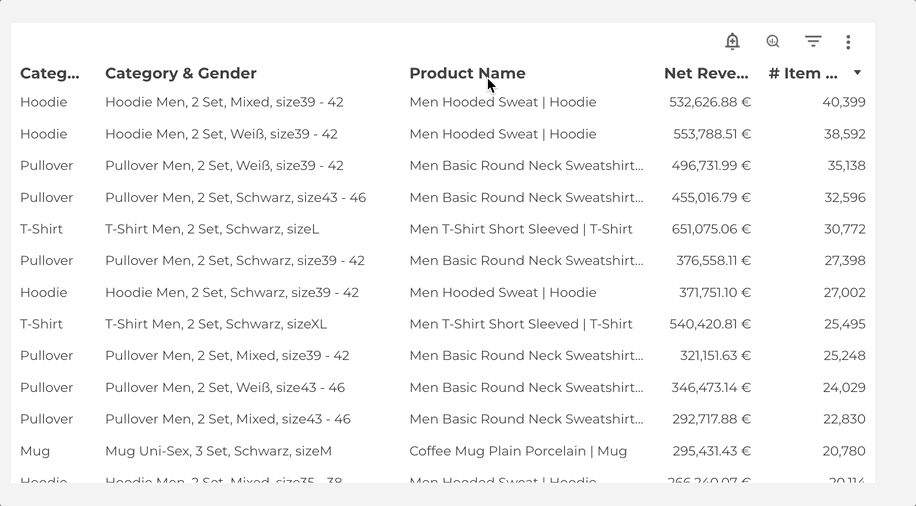
Waterfall charts serve a crucial role in representing cumulative data values and elucidating the contributions of individual components towards a final aggregate. These charts are particularly skilled at illustrating fluctuations in data over time and demonstrating how various factors come together to produce a final result. The essence of a waterfall chart lies in its columns, each of which represents specific data points and shows changes in relation to the previous one.
The initial column represents the base value, while subsequent columns reveal adjustments attributed to various factors. Positive changes are depicted as columns rising above the baseline, while negative changes are shown as columns descending below it. The last column displays the total value after accounting for all the changes.
Going beyond simply illustrating cumulative values, waterfall charts excel at identifying the primary drivers of change within a dataset. Analyzing the size and direction of the columns allows you to pinpoint the factors that had the most significant impact on the final value. This information is immensely valuable for resource allocation, process improvement, and decision-making.
In this blog post, we will explore the creation and utilization of waterfall charts within Looker Studio, Google’s versatile data visualization tool.
Creating a Waterfall Chart
To create a waterfall chart in Looker Studio, follow these steps:
- Firstly, add a new chart or select an existing one
- Use the Properties panel on the right to configure the chart's Setup and Style tab properties. Creating a waterfall chart in Looker necessitates one dimension and one metric
- Optionally, you can choose a date-type dimension in the Date Range Dimension option

For instance, in the table below we possess a collection of monthly financial data that demonstrates how the overall revenue of a company fluctuates throughout the year. It initiates with an initial revenue amount and traces the diverse elements that impact revenue on a monthly basis. As the year unfolds, you can discern the positive effects of new sales and upsells, as well as the obstacles posed by returns, refunds, and customer discounts. Each month, these elements converge to shape the ultimate monthly revenue figure.

In this particular situation, you opt to generate a waterfall chart to illustrate the evolution of your revenue over time. Instead of choosing a conventional line graph that depicts the total number of users as time progresses, a waterfall chart unveils the losses incurred and the influence they exert on subsequent statistics.
Accordingly, the following waterfall chart depicts revenue gains and losses by month, featuring a Total column that showcases the summation of all values.

Limitations in Looker Studio
Waterfall charts are a powerful visualization tool. However, with Looker Studio, users should be aware of certain limitations. One prominent constraint is the lack of flexibility in chart types. Looker Studio primarily supports the standard waterfall chart, which displays both positive and negative values in sequence. While this is effective for understanding how individual factors contribute to a total, it may fall short in situations that require more advanced waterfall chart types, such as stacked or bridge charts, for deeper analysis.
Nevertheless, Looker Studio makes up for this limitation with a compelling feature—drill-down capabilities.
As seen below, we can create a distinct waterfall chart to depict the changes in new sales, upsells, refunds, returns, and discounts over time. This will help us understand their impact on total revenue as time progresses.


By allowing users to explore data in greater detail through optional metrics, Looker Studio enhances interactivity and deepens the analysis.
Conclusion
Waterfall charts hold immense value in data analysis, especially when dealing with multifaceted datasets characterized by gains and losses. They excel at revealing how individual components contribute to an overall total and are indispensable for understanding the dynamics of data changes over time. By mastering the interpretation of waterfall charts, you equip yourself with a potent tool for making informed decisions, identifying trends, and effectively conveying complex data.
More to read
If you enjoyed this blog, you'll love these too! Dive into more captivating content:
6 social media dashboard templates to Elevate Your Data Visualization Game
Latest Updates on Google Data Analytics
Your AI Companion in the Google Cloud
Awakening the Data Messenger by Integrating BigQuery with Slack
Further Links
Follow us on LinkedIn for insights into our daily work and important updates on BigQuery, Data Studio, and marketing analytics.
Subscribe to our YouTube channel for discussions on Data Warehouse, BigQuery, Looker Studio, and Google Tag Manager.
If you are interested in learning BigQuery from scratch, get access to our free BigQuery Course
Elevate your skills with Google Data Studio and BigQuery by enrolling in our Udemy course.
Need help setting up a modern, cost-efficient data warehouse or analytical dashboard? Email us at hello@datadice.io to schedule a call.







